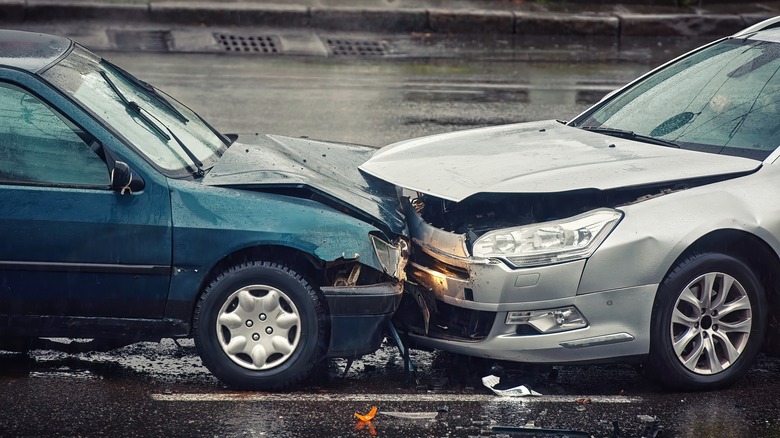Cars are generally safer to drive today partly thanks to the standardization of both simple systems like seat belts and air bags alongside more advanced tools like Automatic Emergency Braking and both built-in and standalone dashcams. However, car accidents are still an unfortunately regular occurrence around the United States. According to the National Highway Traffic Safety Administration, over 40,000 individuals died in car crashes in 2022, with a major contributor to this statistic being distracted drivers.
Advertisement
This is why car manufacturers continue to iterate and improve upon their existing safety systems, utilizing existing data in a constant pursuit to prevent and lessen the impact of various kinds of crashes and accidents. For Toyota, the weapon of choice is Safety Sense, a comprehensive safety package that was first introduced in 2015 and has been included in mid-sized and large vehicles since 2018. Safety Sense is designed to tackle some of the most common types of car accidents through the use of a four-pronged system of driver safety and assistance features.
Safety Sense is designed to address the three most common accident types

Tricky_Shark/Shutterstock
Toyota’s Safety Sense system, or TSS for short, is built with the intent of preventing accidents as much as possible. Obviously, though, you can’t prevent every kind of spontaneous occurrence that may befall a driver on the road, so to keep things focused, the TSS system is designed to tackle three of the most common accident types that have been recorded on the road.
Advertisement
These three accident types are frontal collisions, unintended lane departures, and nighttime accidents. The intent is to warn drivers when their vehicle is about to collide head-on with another driver or solid surface, keep the car firmly within its own lane and out of others’ ways (as well as on the road in general), and enhance a driver’s overall vision and visibility when driving at night. Of course, all of this is implemented with the assumption that a driver is fully alert and following the rules of the road. There aren’t any safety features that will help you if you’re not making an effort to drive safely, after all.
Safety Sense is made up of four safety and driver assistance systems
The TSS utilizes four kinds of systems and technologies – the Pre-Collision System, Dynamic Radar Cruise Control, Lane Departure Alert, and Automatic High Beams.
The Pre-Collision System is constantly monitoring the area in front of the car using a combination of a camera and a radar. If an object is quickly approaching the front of the car, the PCS will use visual and auditory warnings to alert the driver. If the driver engages the brakes, the PCS will also apply additional braking force to ensure the car stops in time, though it can also apply the brakes itself if the driver doesn’t.
Advertisement
Dynamic Radar Cruise Control uses the same camera and radar as the Pre-Collision System to keep the car in a safe speed range on a busy highway. When in use, the camera and radar search for changes in speed in the cars in front of you, adjusting the speed of your cruising to keep a safe distance behind them alongside auditory and visual alerts.
The Lane Departure Alert uses the camera to detect road markings on straight roads and works to keep you firmly within your lane. If the system detects you drifting out of your lane, it will bring it to your attention with auditory and visual alerts. If you continue drifting, the system can make small, corrective inputs to the steering wheel to keep you in your lane.
Advertisement
Finally, Automatic High Beams selectively engages and disengages your headlight high beams based on the presence of drivers around you. If the camera detects headlights coming from the opposite direction, it automatically toggles the high beams off so their vision isn’t obscured, then turns them back on after they pass.
Safety Sense has been upgraded to 3.0 over the years
Since Safety Sense’s initial introduction in 2015, Toyota has been steadily improving it with each subsequent generation of vehicle. As of 2023, Safety Sense has reached version 3.0, carrying over the four core systems of the original system while also adding three additional systems: Lane Tracing Assist, Road Sign Assist, and Proactive Driving Assist.
Advertisement
Lane Tracing Assist activates while using Dynamic Radar Cruise Control, detecting both lane markings and the path and speed of the car directly in front of you. Using this information, the system automatically tweaks your steering to both keep you centered in your lane and at a safe distance from the other car. LTA also monitors for driver awareness while making its adjustments, and if it detects you aren’t engaged with the road, it can bring the car to an emergency stop.
Meanwhile, Road Sign Assist utilizes the car’s camera to detect oncoming road signs and make you more aware of them. When a sign is detected, an image of it is projected on the car’s Multi-Informational Display. This system can detect a variety of different signs, including speed limits, stop signs, do not enter signs, yield signs, and pedestrian crossings.
Advertisement
Last, Proactive Driving Assist works to support the driver with the everyday operation of the car, providing gentle input tweaks to encourage safe driving. This includes subtle brake pressure when driving around corners or steering support when driving around a pedestrian or bicyclist.